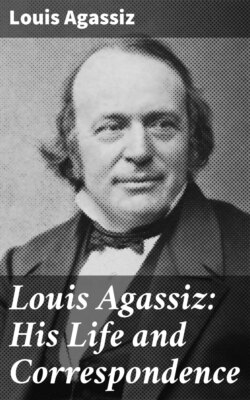Читать книгу Louis Agassiz: His Life and Correspondence - Louis Agassiz - Страница 40
На сайте Литреса книга снята с продажи.
AGASSIZ TO BRAUN.
ОглавлениеNEUCHATEL, June 20, 1827.
. . .Now you shall hear what I know of the "Hebammen Krote." How the fecundation takes place I know not, but it must needs be the same as in other kinds of the related Bombinator; igneus throws out almost as many eggs hanging together in clusters as obstetricans; fuscus throws them out from itself in strings (see Roseld's illustration). . .I have now carefully examined the egg clusters of obstetricans; all the eggs are in one string and hang together. This string is a bag, in which the eggs lie inclosed at different distances, though they seem in the empty space to be fallen, thread-like, together. But if you stretch the thread and press the eggs, they change their places, and you can distinctly see that they lie free in the bag, having their own membranous envelopes corresponding to those of other batrachian eggs. Surely this species seeks the water at the time of fecundation, for so do all batrachians, the water being indeed a more fitting medium for fecundation than the air. . .It is certain that the eggs were already fecundated when we found them in the ground, for later, I found several not so far advanced as those you have, and yet after three weeks I had tadpoles from them. In those eggs which were in the lowest stage of development (how they may be earlier, nescio), nothing was clearly visible; they were simply little yellow balls. After some days, two small dark spots were to be seen marking the position of the eyes, and a longitudinal streak indicated the dorsal ridge. Presently everything became more distinct; the mouth and the nasal opening, the eyes and the tail, which lay in a half circle around the body; the skin was so transparent that the beating of the heart and the blood in the vessels could be easily distinguished; the yolk and the yolk sac were meanwhile sensibly diminished. The movements of the little animal were now quite perceptible,—they were quick and by starts. After three or four weeks the eggs were as large as peas; the bags had burst at the spots where the eggs were attached, and the little creatures filled the egg envelopes completely. They moved incessantly and very quickly. Now the female stripped off the eggs from her legs; she seemed very uneasy, and sprang about constantly in the tank, but grew more quiet when I threw in more water. The eggs were soon free, and I laid them in a shallow vessel filled with fresh water. The restlessness among them now became greater, and behold! like lightning, a little tadpole slipped out of its egg, paused astonished, gazed on the greatness of the world, made some philanthropic observations, and swam quickly away. I gave them fresh water often, and tender green plants as well as bread to eat. They ate eagerly. Up to this time their different stages of development had been carefully drawn by my sister. I now went to Vallorbe; they promised at home to take care of my young brood, but when I returned the tadpoles had been forgotten, and I found them all dead; not yet decayed, however, and I could therefore preserve them in alcohol. The gills I have never seen, but I will watch to see whether they are turned inward. . .
